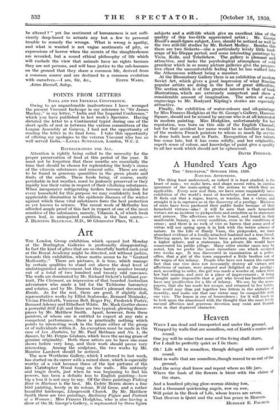Art
THE London Group exhibition which opened last Monday at the Burlington Galleries is profoundly disappointing. In fact the kind of gibes that are so cheerfully hurled each year at the Royal Academy might be directed, not without justice, towards this exhibition, whose motto seems to be " Genteel Mediocrity." There are pictures, it is true, which manage by certain qualities to stand out above the dead level of undistinguished achievement, but they barely number twenty out of a total of two hundred and twenty odd canvases. The walls are dominated by Mr. Richard Sickert's brilliant por- trait, The Claimant, an impression of that bearded Australian adventurer who made a bid for the Tichborne baronetcy and estates, and by Mr. Duncan Grant's pleasant decoration, Rondo. As for the rest, there are good, if slightly dull, representative works by Elliot Seabrooke, Bernard Meninsky, Vivian Pitchforth, Vanessa Bell, Roger Fry, Frederick Porter, Bernard Adeney and Ethelbert White. Mr. Mark Gertler shows a powerful Still Life and there are two typical, glowing Rower- pieces by Mr. Matthew Smith. Apart, however, from these painters, of whom one is entitled to expect at any rate a competent performance, there is practically nothing which points to interesting work in the future either of the group or of individuals within it. An exception must be made in the case of Les Abattoirs, by Mr. Paul Methuen and No. 1, the Square, by Mr. Fergus Graham, which have the saving grace of genuine originality. Both these artists are to have one-man shows before very long, and their work should prove very interesting. Among the sculpture, the two works by Mr. Maurice Lambert should be noticed.
The new Wertheim Gallery, which I referred to last week, has started on its career with a mixed show, which is especially worthy of a visit because three of the last pictures of the late Christopher Wood hang on the walls. His untimely and tragic death, just when he was beginning to find his powers, has been a definite loss to English painting—how big a loss it is not easy to say. Of the three paintings Fishing Boat in Harbour is the best. Mf. Cedrid Monis shMvs a fine bird painting, lovely in its colour, Wild Geese, and a rather beautiful landscape, Llangennith Church. By Mr. Matthew Smith there are two paintings, Reclining Figure and Portrait of a Woman ; Miss Frances Hodgkins, who is also having a show at the St. George's Gallery, is represented by three figure subjects and a still-life which give an excellent idea of the quality of this too-little appreciated artist ; Mr. George Bissill's small-figure subject, Love, should be noticed as well as the two still-life studies by Mr. Robert Medley. Besides this there are two Sickerts—one a particularly lovely little land- scape of his Dieppe period, and some interesting paintings by Vivin, Kolle, and Tehelichew. The gallery is pleasant and attractive, and lacks the psychological atmosphere of cold grandeur which in so many picture galleries give the prospec- tive client the uncomfortable feeling that he has walked into the Athenaeum without being a member.
At the Bloomsbury Gallery there is an exhibition of modern Soviet Art, which gives a good impression of what Russian 'popular artists are doing m the face of great difficulties. The section which is of the greatest interest is that of book illustrations, which are extremely competent and show a considerable amount of imagination. The series of wood- engravings to Mr. Rudyard Kipling's stories are especially attractive.
Finally, the exhibition of water-colours and oil-paintings by Miss Frances Hodgkins at the St. George's Gallery, Hanover Square, should not be missed by anyone who is at all interested in modern painting. Miss Hodgkins, unfortunately for her reputation, was born on this side of the English Channel; but for that accident her name would be as familiar as those of the modern French painters to whom so much lip service is done both here and in Paris.. Recognition of her talents has come late, but it has come solidly, and her originality, superb sense of colour, and knowledge of paint give a quality to all her work which should not be ephemeral.
DAVID FINCIIAM.
























































 Previous page
Previous page